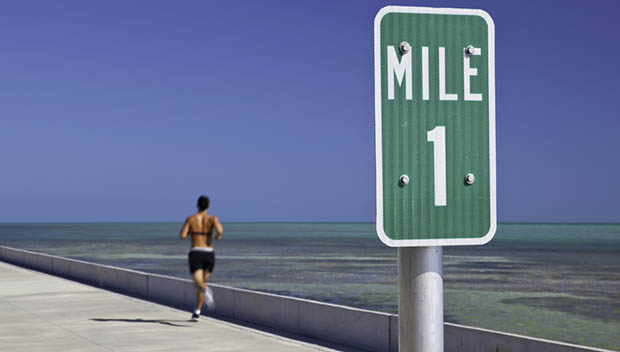
A single mile. 1,609 meters. 5,280 feet. Compared to 13.1 or 26.2-mile races, it doesn't get much glory or attention, but running a fast mile is an impressive achievement in its own right. While most track races (like the 400m or 800m) are now based on the metric system, the mile is the only remaining imperial distance event.
The mile is also still recognized by the International Association of Athletics Federations (IAAF) with a world record—which is why you'll still see elites lining up to race it at events like the annual Millrose Games and the Fifth Avenue Mile in New York City. So, it's a draw for pros, but what's in it for the average age-grouper? Plenty.
For starters, the mile is accessible to runners of all abilities. Whether you're a newbie or have run countless distance races, the mile provides a challenge without beating up your legs. For many runners, training for longer races can take a serious physical toll. Whether it's because of age, a busy schedule or injury prone tendons, high mileage and long weekend runs aren't always an option. Luckily, training for a mile looks very different. Most runners can improve their time with lower mileage and shorter (albeit more intense) workouts.
Another reason to embrace the mile is that you can race nearly every weekend if you want. For most marathoners, the most they can target is two races per year. And if race day happens to be extraordinarily hot or a stomach bug hits, that training cycle is pretty much in the tank. 10Ks and 5Ks can be run more often, but they still require a decent amount of recovery. But the mile is long enough to bring on a sense of accomplishment (and maybe a runner's high), but short enough that you'll be able to jog the next day, if you want.
And one of the best reasons to line up for a mile race? It's over quickly! Sure, it brings you to the pain cave, but most runners will finish before their playlist can spit out two songs—three max. If you're hurting, remind yourself that you can do anything for a few minutes—probably less than 10!
If you're convinced, here's how to get ready to race:
- Build a base. You don’t need to log double-digit long runs or crazy mileage, but take a few weeks to increase your endurance. Aim for three to four easy runs per week, with a slightly longer effort on the weekend.
- Add in strides. Once you’re comfortable with easy runs, begin adding in strides (80-100m accelerations) after most of your easy runs. As you get better at those, consider adding in high intensity (but short) hill sprints to improve your power, neuromuscular coordination and glute activation. All key for faster efforts!
- Finally, work on specificity for a few weeks. To run fast, you have to practice running fast. Once a week, run a number of short repeats (200-400m) at your mile goal pace with a short recovery jog (1-2 minutes) in between.
When you’re ready to give the mile distance a try (whether on your own or at a sanctioned event), aim for a quality warm-up of at least 2 miles. Follow that with a few strides at or faster than your goal pace. Finally, give yourself 5-10 minutes to catch your breath before you toe the line. You’ll have a shiny new mile time before you know it!
READ THIS NEXT: How to Run a Personal Distance Record


